Loss of Blood-Brain Barrier Integrity in an In Vitro Model Subjected to Intermittent Hypoxia: Is Reversion Possible with a HIF-1α Pathway Inhibitor?
Abstract
1. Introduction
2. Results
2.1. Hydralazine and IH Induce HIF-1α Expression
2.2. Hydralazine-Induced HIF-1α Pathway Is Involved in BBB Impairment
2.2.1. Inhibition of HIF-1 Abolishes Hydralazine-Induced BBB Hyperpermeability
2.2.2. YC-1 Reverses Hydralazine-Induced Alterations in Expression of Tight Junction Proteins
2.2.3. YC-1 Reverses Hydralazine-Induced Overexpression of ABC Efflux Transporters Proteins
2.3. IH-Induced HIF-1α Pathway Is Involved in BBB Impairments
2.3.1. YC-1 Reverses IH-Induced Hyperpermeability
2.3.2. YC-1 Reversed IH Impact on the Level of Tight Junction Proteins
2.3.3. YC-1 Reversed IH Impact on the Level of ABC Efflux Transporter Proteins
3. Discussion
3.1. Prevention of BBB Impairment by Inhibition of HIF-1α with Hydralazine
3.2. Prevention of IH-Induced BBB Impairment by Inhibition of the HIF-1 Pathway
4. Materials and Methods
4.1. Chemicals and Reagents
4.2. In Vitro BBB Model
4.3. Exposure to IH
4.3.1. Chemical Induction with Hydralazine
4.3.2. Physical Induction with a Hypoxia Chamber
4.4. Transendothelial Electrical Resistance (TEER) Measurements
4.5. Na-Fl Permeability Measurements
4.6. Whole Cell ELISA Assay
4.6.1. Determination of HIF-1α Content
4.6.2. Inhibition of HIF-1α Pathway
4.7. Statistical Analysis
Author Contributions
Funding
Data Availability Statement
Conflicts of Interest
Abbreviation
| BBB | Blood-brain barrier |
| Cld | Claudin |
| CPAP | Continuous Positive Airway Pressure |
| HIF | Hypoxia Inducible Factor |
| IH | Intermittent Hypoxia |
| MRP | Multidrug Resistance Protein |
| Na-Fl | Sodium-Fluorescein |
| NF-κB | Nuclear Factor-Kappa B |
| Nrf2 | Nuclear Factor Rrythroid-2-related Factor 2 |
| OSAS | Obstructive Sleep Apnea Syndrome |
| Papp | apparent permeability |
| P-gp | P-glycoprotein |
| PHD | Prolyl Hydroxylases |
| ROS | Reactive Oxygen Species |
| TEER | Trans-Endothelial Electrical Resistance |
| VEGF | Vascular Endothelial Growth Factor |
| YC-1 | 3-(5′-hydroxyethyl-2′-furyl)-1-benzylindazole |
| ZO | Zonula Occludens |
References
- Ogunshola, O.O.; Al-Ahmad, A. HIF-1 at the Blood-Brain Barrier: A Mediator of Permeability? High Alt. Med. Biol. 2012, 13, 153–161. [Google Scholar] [CrossRef]
- Keller, A. Breaking and Building the Wall: The Biology of the Blood-Brain Barrier in Health and Disease. Swiss Med. Wkly. 2013, 143, w13892. [Google Scholar] [CrossRef] [PubMed]
- Abbott, N.J.; Friedman, A. Overview and Introduction: The Blood-Brain Barrier in Health and Disease. Epilepsia 2012, 53 (Suppl. S6), 1–6. [Google Scholar] [CrossRef] [PubMed]
- Obermeier, B.; Daneman, R.; Ransohoff, R.M. Development, Maintenance and Disruption of the Blood-Brain Barrier. Nat. Med. 2013, 19, 1584–1596. [Google Scholar] [CrossRef] [PubMed]
- Al Ahmad, A.; Taboada, C.B.; Gassmann, M.; Ogunshola, O.O. Astrocytes and Pericytes Differentially Modulate Blood-Brain Barrier Characteristics during Development and Hypoxic Insult. J. Cereb. Blood Flow Metab. Off. J. Int. Soc. Cereb. Blood Flow Metab. 2011, 31, 693–705. [Google Scholar] [CrossRef]
- Brillault, J.; Berezowski, V.; Cecchelli, R.; Dehouck, M.-P. Intercommunications between Brain Capillary Endothelial Cells and Glial Cells Increase the Transcellular Permeability of the Blood-Brain Barrier during Ischaemia. J. Neurochem. 2002, 83, 807–817. [Google Scholar] [CrossRef]
- Hayashi, K.; Nakao, S.; Nakaoke, R.; Nakagawa, S.; Kitagawa, N.; Niwa, M. Effects of Hypoxia on Endothelial/Pericytic Co-Culture Model of the Blood-Brain Barrier. Regul. Pept. 2004, 123, 77–83. [Google Scholar] [CrossRef]
- Lochhead, J.J.; Ronaldson, P.T.; Davis, T.P. Hypoxic Stress and Inflammatory Pain Disrupt Blood-Brain Barrier Tight Junctions: Implications for Drug Delivery to the Central Nervous System. AAPS J. 2017, 19, 910–920. [Google Scholar] [CrossRef]
- Blackwell, T.; Yaffe, K.; Laffan, A.; Redline, S.; Ancoli-Israel, S.; Ensrud, K.E.; Song, Y.; Stone, K.L. Associations between Sleep-Disordered Breathing, Nocturnal Hypoxemia, and Subsequent Cognitive Decline in Older Community-Dwelling Men: The Osteoporotic Fractures in Men Sleep Study. J. Am. Geriatr. Soc. 2015, 63, 453–461. [Google Scholar] [CrossRef]
- Kerner, N.A.; Roose, S.P.; Pelton, G.H.; Ciarleglio, A.; Scodes, J.; Lentz, C.; Sneed, J.R.; Devanand, D.P. Association of Obstructive Sleep Apnea with Episodic Memory and Cerebral Microvascular Pathology: A Preliminary Study. Am. J. Geriatr. Psychiatry Off. J. Am. Assoc. Geriatr. Psychiatry 2017, 25, 316–325. [Google Scholar] [CrossRef]
- Sforza, E.; Roche, F.; Thomas-Anterion, C.; Kerleroux, J.; Beauchet, O.; Celle, S.; Maudoux, D.; Pichot, V.; Laurent, B.; Barthélémy, J.C. Cognitive Function and Sleep Related Breathing Disorders in a Healthy Elderly Population: The SYNAPSE Study. Sleep 2010, 33, 515–521. [Google Scholar] [CrossRef] [PubMed]
- Palomares, J.A.; Tummala, S.; Wang, D.J.J.; Park, B.; Woo, M.A.; Kang, D.W.; St Lawrence, K.S.; Harper, R.M.; Kumar, R. Water Exchange across the Blood-Brain Barrier in Obstructive Sleep Apnea: An MRI Diffusion-Weighted Pseudo-Continuous Arterial Spin Labeling Study. J. Neuroimaging Off. J. Am. Soc. Neuroimaging 2015, 25, 900–905. [Google Scholar] [CrossRef] [PubMed]
- Rosenzweig, I.; Glasser, M.; Polsek, D.; Leschziner, G.D.; Williams, S.C.R.; Morrell, M.J. Sleep Apnoea and the Brain: A Complex Relationship. Lancet Respir. Med. 2015, 3, 404–414. [Google Scholar] [CrossRef] [PubMed]
- Kerner, N.A.; Roose, S.P. Obstructive Sleep Apnea Is Linked to Depression and Cognitive Impairment: Evidence and Potential Mechanisms. Am. J. Geriatr. Psychiatry Off. J. Am. Assoc. Geriatr. Psychiatry 2016, 24, 496–508. [Google Scholar] [CrossRef] [PubMed]
- Baronio, D.; Martinez, D.; Fiori, C.Z.; Bambini-Junior, V.; Forgiarini, L.F.; Pase da Rosa, D.; Kim, L.J.; Cerski, M.R. Altered Aquaporins in the Brains of Mice Submitted to Intermittent Hypoxia Model of Sleep Apnea. Respir. Physiol. Neurobiol. 2013, 185, 217–221. [Google Scholar] [CrossRef]
- Sawyer, A.M.; Gooneratne, N.S.; Marcus, C.L.; Ofer, D.; Richards, K.C.; Weaver, T.E. A Systematic Review of CPAP Adherence across Age Groups: Clinical and Empiric Insights for Developing CPAP Adherence Interventions. Sleep Med. Rev. 2011, 15, 343–356. [Google Scholar] [CrossRef]
- Hobzova, M.; Hubackova, L.; Vanek, J.; Genzor, S.; Ociskova, M.; Grambal, A.; Prasko, J. Cognitive Function and Depressivity before and after Cpap Treatment in Obstructive Sleep Apnea Patients. Neuro Endocrinol. Lett. 2017, 38, 145–153. [Google Scholar]
- Richards, K.C.; Gooneratne, N.; Dicicco, B.; Hanlon, A.; Moelter, S.; Onen, F.; Wang, Y.; Sawyer, A.; Weaver, T.; Lozano, A.; et al. CPAP Adherence May Slow 1-Year Cognitive Decline in Older Adults with Mild Cognitive Impairment and Apnea. J. Am. Geriatr. Soc. 2019, 67, 558–564. [Google Scholar] [CrossRef]
- Lim, D.C.; Pack, A.I. Obstructive Sleep Apnea and Cognitive Impairment: Addressing the Blood-Brain Barrier. Sleep Med. Rev. 2014, 18, 35–48. [Google Scholar] [CrossRef]
- Engelhardt, S.; Al-Ahmad, A.J.; Gassmann, M.; Ogunshola, O.O. Hypoxia Selectively Disrupts Brain Microvascular Endothelial Tight Junction Complexes through a Hypoxia-Inducible Factor-1 (HIF-1) Dependent Mechanism. J. Cell. Physiol. 2014, 229, 1096–1105. [Google Scholar] [CrossRef]
- Semenza, G.L. Regulation of Oxygen Homeostasis by Hypoxia-Inducible Factor 1. Physiology 2009, 24, 97–106. [Google Scholar] [CrossRef] [PubMed]
- Yang, M.; Chen, Y.; Wu, Z.; Zhang, Y.; Cai, R.; Ye, L.; Huang, Y.; Wang, L.; He, H. The Impact of Chronic Intermittent Hypoxia on the Expression of Intercellular Cell Adhesion Molecule-1 and Vascular Endothelial Growth Factor in the Ischemia-Reperfusion Rat Model. Folia Neuropathol. 2018, 56, 159–166. [Google Scholar] [CrossRef] [PubMed]
- Prabhakar, N.R.; Semenza, G.L. Adaptive and Maladaptive Cardiorespiratory Responses to Continuous and Intermittent Hypoxia Mediated by Hypoxia-Inducible Factors 1 and 2. Physiol. Rev. 2012, 92, 967–1003. [Google Scholar] [CrossRef] [PubMed]
- Semenza, G.L. Hypoxia-Inducible Factor 1 and Cardiovascular Disease. Annu. Rev. Physiol. 2014, 76, 39–56. [Google Scholar] [CrossRef] [PubMed]
- Nanduri, J.; Yuan, G.; Kumar, G.K.; Semenza, G.L.; Prabhakar, N.R. Transcriptional Responses to Intermittent Hypoxia. Respir. Physiol. Neurobiol. 2008, 164, 277–281. [Google Scholar] [CrossRef] [PubMed]
- Lim, D.C.; Pack, A.I. Obstructive Sleep Apnea: Update and Future. Annu. Rev. Med. 2017, 68, 99–112. [Google Scholar] [CrossRef]
- Chatard, M.; Puech, C.; Perek, N.; Roche, F. Hydralazine Is a Suitable Mimetic Agent of Hypoxia to Study the Impact of Hypoxic Stress on In Vitro Blood-Brain Barrier Model. Cell. Physiol. Biochem. Int. J. Exp. Cell. Physiol. Biochem. Pharmacol. 2017, 42, 1592–1602. [Google Scholar] [CrossRef]
- Chatard, M.; Puech, C.; Roche, F.; Perek, N. Hypoxic Stress Induced by Hydralazine Leads to a Loss of Blood-Brain Barrier Integrity and an Increase in Efflux Transporter Activity. PLoS ONE 2016, 11, e0158010. [Google Scholar] [CrossRef]
- Knowles, H.J.; Tian, Y.-M.; Mole, D.R.; Harris, A.L. Novel Mechanism of Action for Hydralazine: Induction of Hypoxia-Inducible Factor-1alpha, Vascular Endothelial Growth Factor, and Angiogenesis by Inhibition of Prolyl Hydroxylases. Circ. Res. 2004, 95, 162–169. [Google Scholar] [CrossRef]
- Mehrabani, M.; Nematollahi, M.H.; Tarzi, M.E.; Juybari, K.B.; Abolhassani, M.; Sharifi, A.M.; Paseban, H.; Saravani, M.; Mirzamohammadi, S. Protective Effect of Hydralazine on a Cellular Model of Parkinson’s Disease: A Possible Role of Hypoxia-Inducible Factor (HIF)-1α. Biochem. Cell Biol. 2020, 98, 405–414. [Google Scholar] [CrossRef]
- Yang, F.; Zhou, L.; Wang, D.; Wang, Z.; Huang, Q.-Y. Minocycline Ameliorates Hypoxia-Induced Blood-Brain Barrier Damage by Inhibition of HIF-1α through SIRT-3/PHD-2 Degradation Pathway. Neuroscience 2015, 304, 250–259. [Google Scholar] [CrossRef] [PubMed]
- Minoves, M.; Morand, J.; Perriot, F.; Chatard, M.; Gonthier, B.; Lemarié, E.; Menut, J.-B.; Polak, J.; Pépin, J.-L.; Godin-Ribuot, D.; et al. An Innovative Intermittent Hypoxia Model for Cell Cultures Allowing Fast Po(2) Oscillations with Minimal Gas Consumption. Am. J. Physiol. Cell Physiol. 2017, 313, C460–C468. [Google Scholar] [CrossRef] [PubMed]
- Puech, C.; Hodin, S.; Forest, V.; He, Z.; Mismetti, P.; Delavenne, X.; Perek, N. Assessment of HBEC-5i Endothelial Cell Line Cultivated in Astrocyte Conditioned Medium as a Human Blood-Brain Barrier Model for ABC Drug Transport Studies. Int. J. Pharm. 2018, 551, 281–289. [Google Scholar] [CrossRef] [PubMed]
- Beaudin, A.E.; Waltz, X.; Hanly, P.J.; Poulin, M.J. Impact of Obstructive Sleep Apnoea and Intermittent Hypoxia on Cardiovascular and Cerebrovascular Regulation. Exp. Physiol. 2017, 102, 743–763. [Google Scholar] [CrossRef]
- Bucks, R.S.; Olaithe, M.; Eastwood, P. Neurocognitive Function in Obstructive Sleep Apnoea: A Meta-Review. Respirology 2013, 18, 61–70. [Google Scholar] [CrossRef]
- Tsui, L.; Fong, T.-H.; Wang, I.-J. The Effect of 3-(5’-Hydroxymethyl-2’-Furyl)-1-Benzylindazole (YC-1) on Cell Viability under Hypoxia. Mol. Vis. 2013, 19, 2260–2273. [Google Scholar]
- Yan, J.; Zhou, B.; Taheri, S.; Shi, H. Differential Effects of HIF-1 Inhibition by YC-1 on the Overall Outcome and Blood-Brain Barrier Damage in a Rat Model of Ischemic Stroke. PLoS ONE 2011, 6, e27798. [Google Scholar] [CrossRef]
- Ding, Z.; Yang, L.; Xie, X.; Xie, F.; Pan, F.; Li, J.; He, J.; Liang, H. Expression and Significance of Hypoxia-Inducible Factor-1 Alpha and MDR1/P-Glycoprotein in Human Colon Carcinoma Tissue and Cells. J. Cancer Res. Clin. Oncol. 2010, 136, 1697–1707. [Google Scholar] [CrossRef]
- Yeh, W.-L.; Lu, D.-Y.; Lin, C.-J.; Liou, H.-C.; Fu, W.-M. Inhibition of Hypoxia-Induced Increase of Blood-Brain Barrier Permeability by YC-1 through the Antagonism of HIF-1alpha Accumulation and VEGF Expression. Mol. Pharmacol. 2007, 72, 440–449. [Google Scholar] [CrossRef]
- Won, S.; Sayeed, I.; Peterson, B.L.; Wali, B.; Kahn, J.S.; Stein, D.G. Vitamin D Prevents Hypoxia/Reoxygenation-Induced Blood-Brain Barrier Disruption via Vitamin D Receptor-Mediated NF-KB Signaling Pathways. PLoS ONE 2015, 10, e0122821. [Google Scholar] [CrossRef]
- Zhao, H.; Zhang, Q.; Xue, Y.; Chen, X.; Haun, R.S. Effects of Hyperbaric Oxygen on the Expression of Claudins after Cerebral Ischemia-Reperfusion in Rats. Exp. Brain Res. 2011, 212, 109–117. [Google Scholar] [CrossRef] [PubMed]
- Mark, K.S.; Davis, T.P. Cerebral Microvascular Changes in Permeability and Tight Junctions Induced by Hypoxia-Reoxygenation. Am. J. Physiol. Heart Circ. Physiol. 2002, 282, H1485–H1494. [Google Scholar] [CrossRef] [PubMed]
- Dopp, J.M.; Moran, J.J.; Abel, N.J.; Wiegert, N.A.; Cowgill, J.B.; Olson, E.B.; Sims, J.J. Influence of Intermittent Hypoxia on Myocardial and Hepatic P-Glycoprotein Expression in a Rodent Model. Pharmacotherapy 2009, 29, 365–372. [Google Scholar] [CrossRef] [PubMed]
- Xiao-Dong, L.; Zhi-Hong, Y.; Hui-Wen, Y. Repetitive/Temporal Hypoxia Increased P-Glycoprotein Expression in Cultured Rat Brain Microvascular Endothelial Cells in Vitro. Neurosci. Lett. 2008, 432, 184–187. [Google Scholar] [CrossRef] [PubMed]
- Robertson, S.J.; Kania, K.D.; Hladky, S.B.; Barrand, M.A. P-Glycoprotein Expression in Immortalised Rat Brain Endothelial Cells: Comparisons Following Exogenously Applied Hydrogen Peroxide and after Hypoxia-Reoxygenation. J. Neurochem. 2009, 111, 132–141. [Google Scholar] [CrossRef]
- Ibbotson, K.; Yell, J.; Ronaldson, P.T. Nrf2 Signaling Increases Expression of ATP-Binding Cassette Subfamily C MRNA Transcripts at the Blood-Brain Barrier Following Hypoxia-Reoxygenation Stress. Fluids Barriers CNS 2017, 14, 6. [Google Scholar] [CrossRef] [PubMed]
- Zolotoff, C.; Voirin, A.-C.; Puech, C.; Roche, F.; Perek, N. Intermittent Hypoxia and Its Impact on Nrf2/HIF-1α Expression and ABC Transporters: An in Vitro Human Blood-Brain Barrier Model Study. Cell. Physiol. Biochem. Int. J. Exp. Cell. Physiol. Biochem. Pharmacol. 2020, 54, 1231–1248. [Google Scholar] [CrossRef]
- Kaspar, J.W.; Niture, S.K.; Jaiswal, A.K. Nrf2:INrf2 (Keap1) Signaling in Oxidative Stress. Free Radic. Biol. Med. 2009, 47, 1304–1309. [Google Scholar] [CrossRef]
- Voirin, A.-C.; Perek, N.; Roche, F. Inflammatory Stress Induced by a Combination of Cytokines (IL-6, IL-17, TNF-α) Leads to a Loss of Integrity on BEnd.3 Endothelial Cells in Vitro BBB Model. Brain Res. 2020, 1730, 146647. [Google Scholar] [CrossRef]
- Nadeem, R.; Molnar, J.; Madbouly, E.M.; Nida, M.; Aggarwal, S.; Sajid, H.; Naseem, J.; Loomba, R. Serum Inflammatory Markers in Obstructive Sleep Apnea: A Meta-Analysis. J. Clin. Sleep Med. JCSM Off. Publ. Am. Acad. Sleep Med. 2013, 9, 1003–1012. [Google Scholar] [CrossRef]
- Voirin, A.-C.; Celle, S.; Perek, N.; Roche, F. Sera of Elderly Obstructive Sleep Apnea Patients Alter Blood-Brain Barrier Integrity in Vitro: A Pilot Study. Sci. Rep. 2020, 10, 11309. [Google Scholar] [CrossRef] [PubMed]
- Zolotoff, C.; Puech, C.; Roche, F.; Perek, N. Effects of Intermittent Hypoxia with Thrombin in an in Vitro Model of Human Brain Endothelial Cells and Their Impact on PAR-1/PAR-3 Cleavage. Sci. Rep. 2022, 12, 12305. [Google Scholar] [CrossRef] [PubMed]
- Argaw, A.T.; Gurfein, B.T.; Zhang, Y.; Zameer, A.; John, G.R. VEGF-Mediated Disruption of Endothelial CLN-5 Promotes Blood-Brain Barrier Breakdown. Proc. Natl. Acad. Sci. USA 2009, 106, 1977–1982. [Google Scholar] [CrossRef] [PubMed]
- Pekny, M.; Wilhelmsson, U.; Tatlisumak, T.; Pekna, M. Astrocyte Activation and Reactive Gliosis—A New Target in Stroke? Neurosci. Lett. 2019, 689, 45–55. [Google Scholar] [CrossRef]
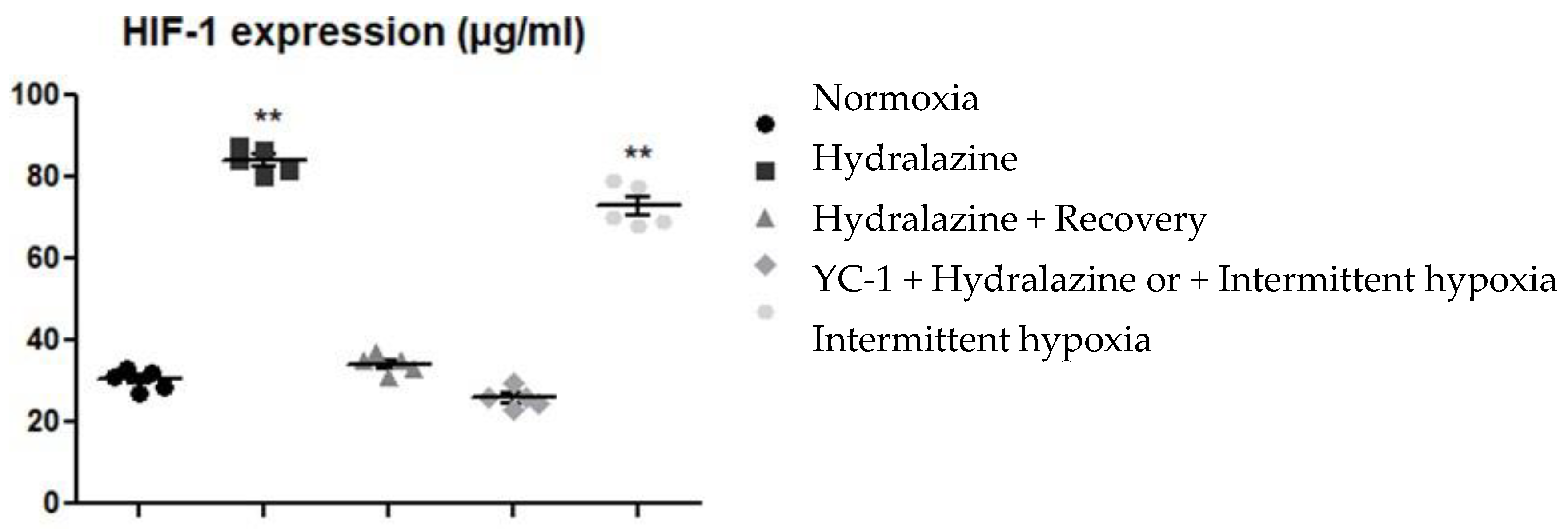
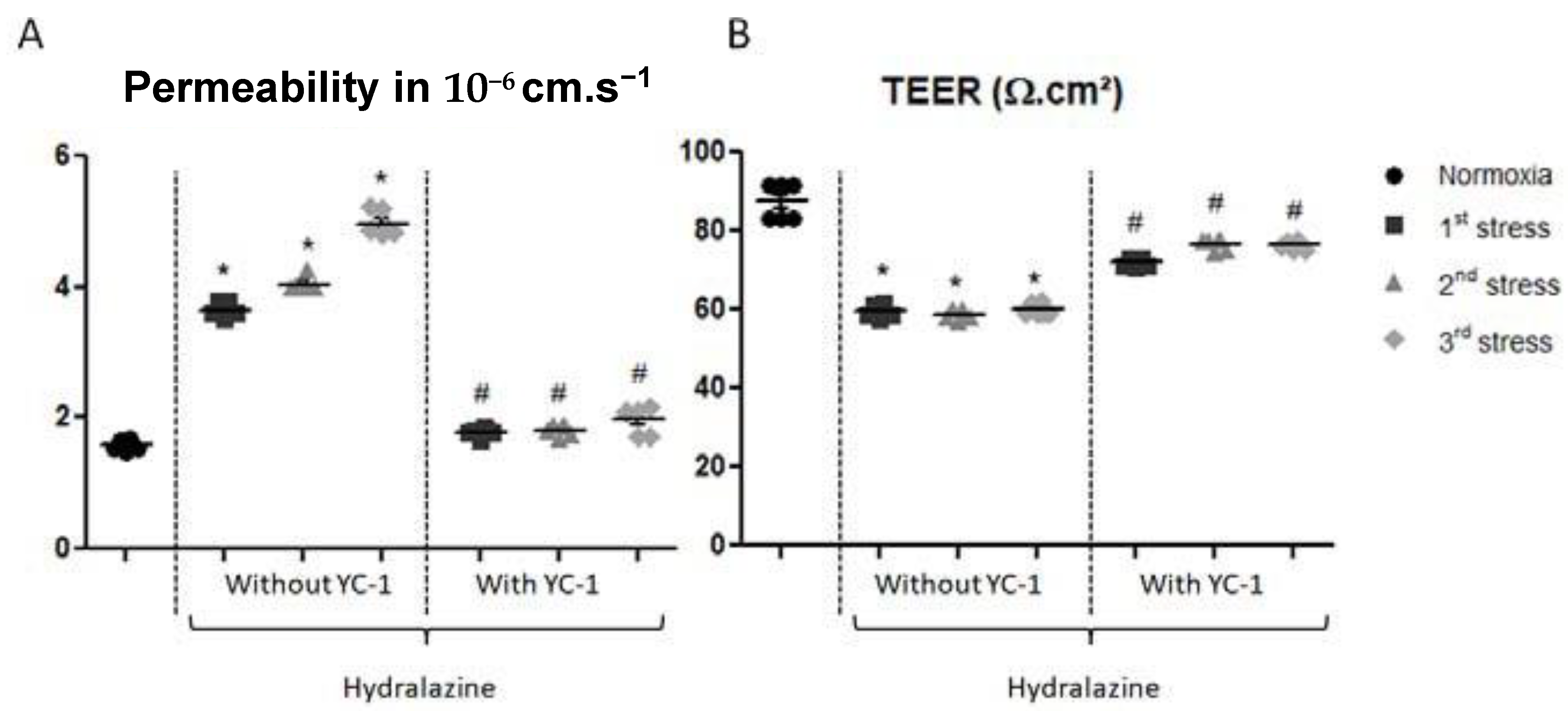
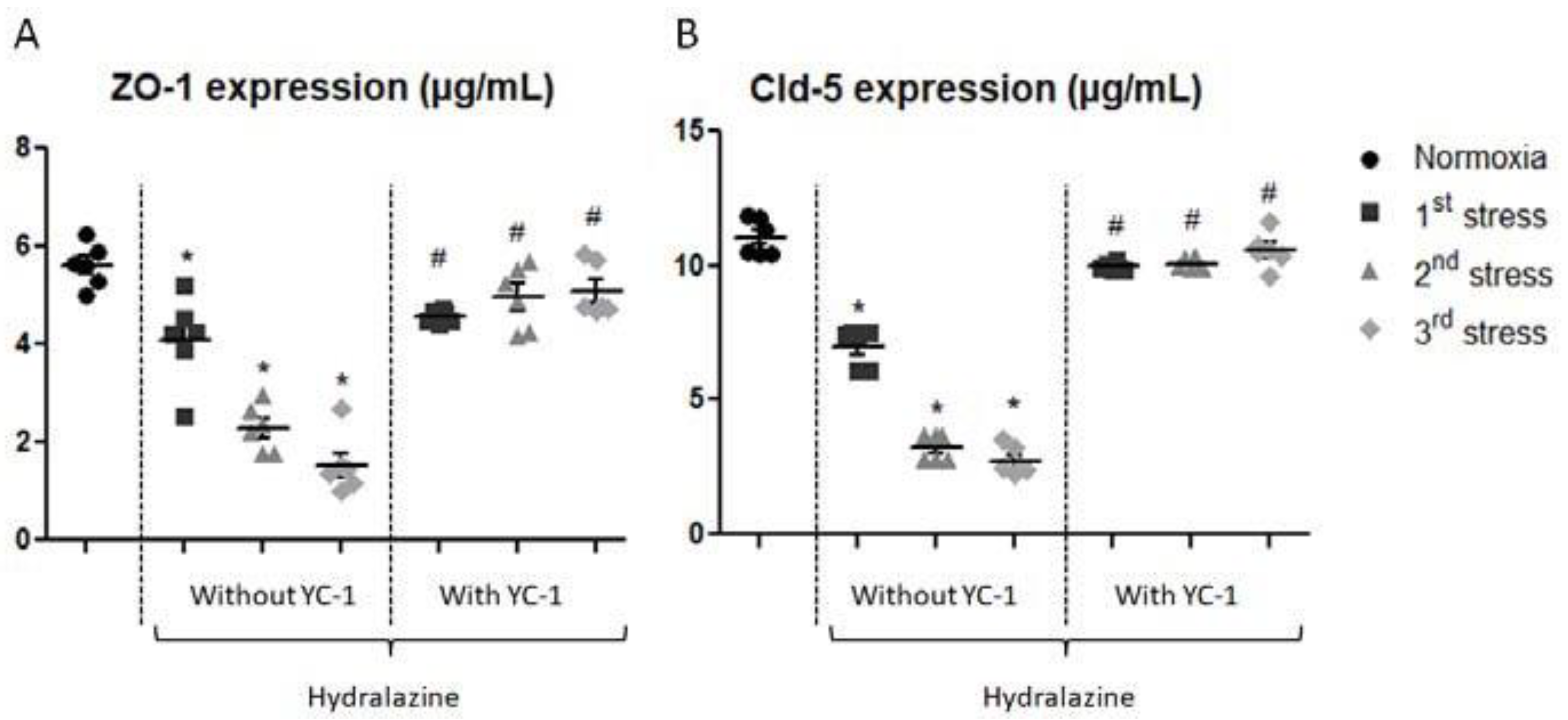
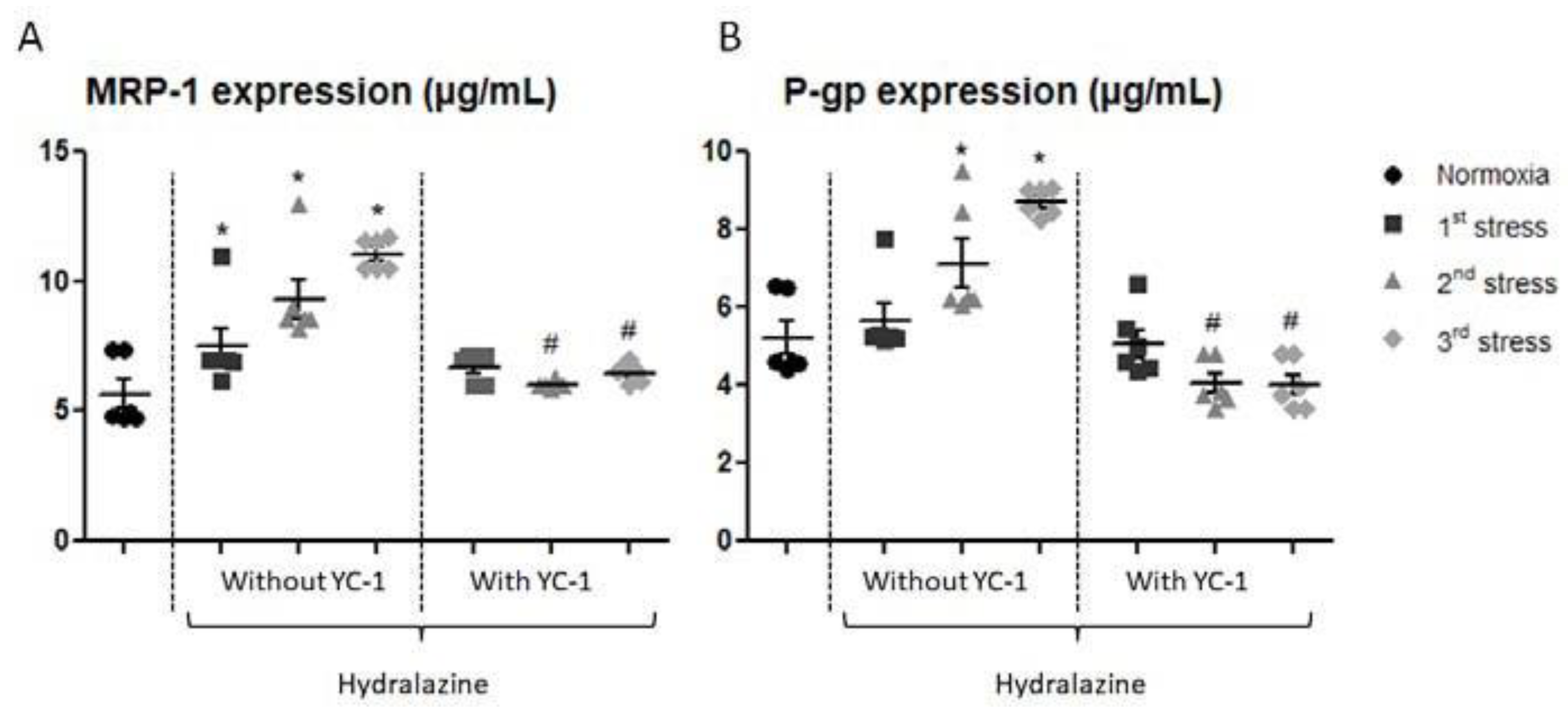

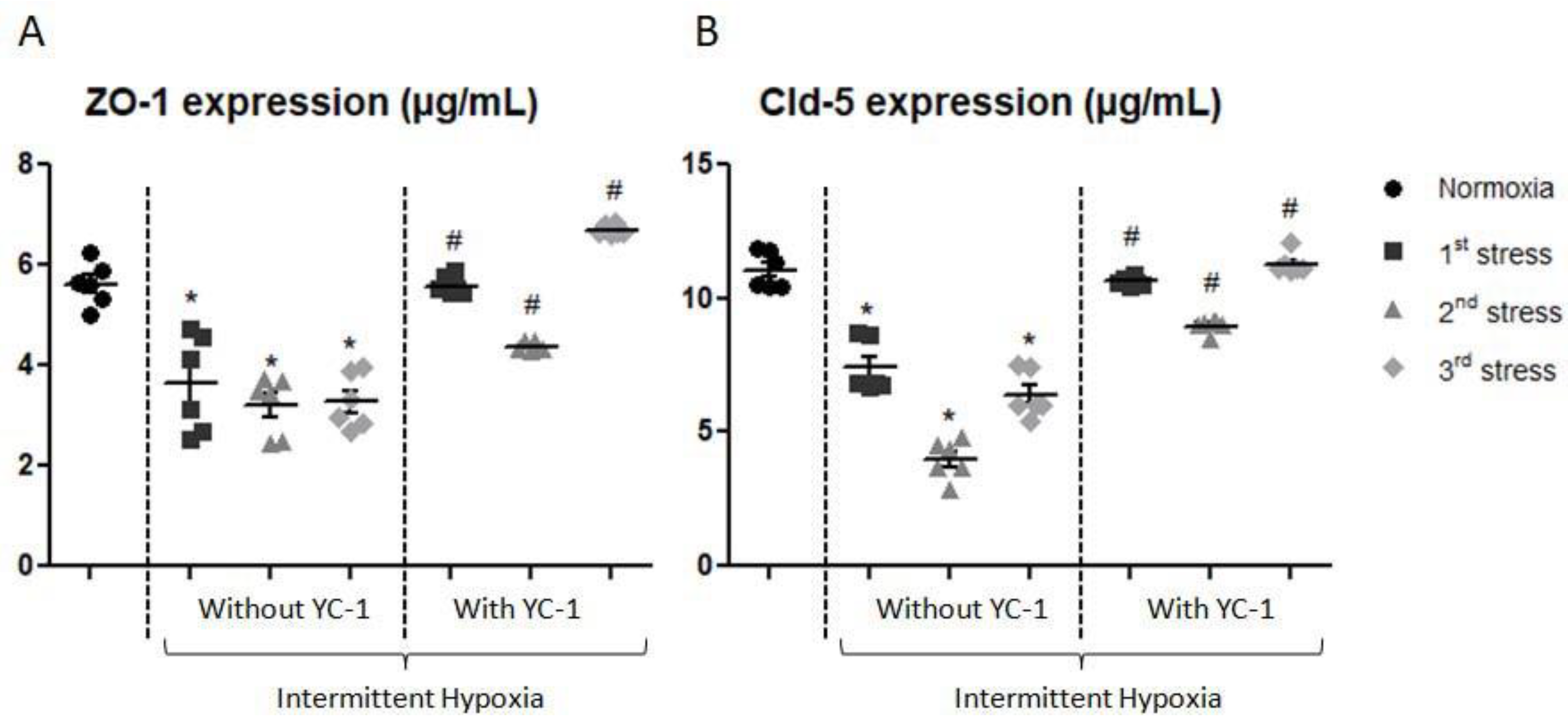
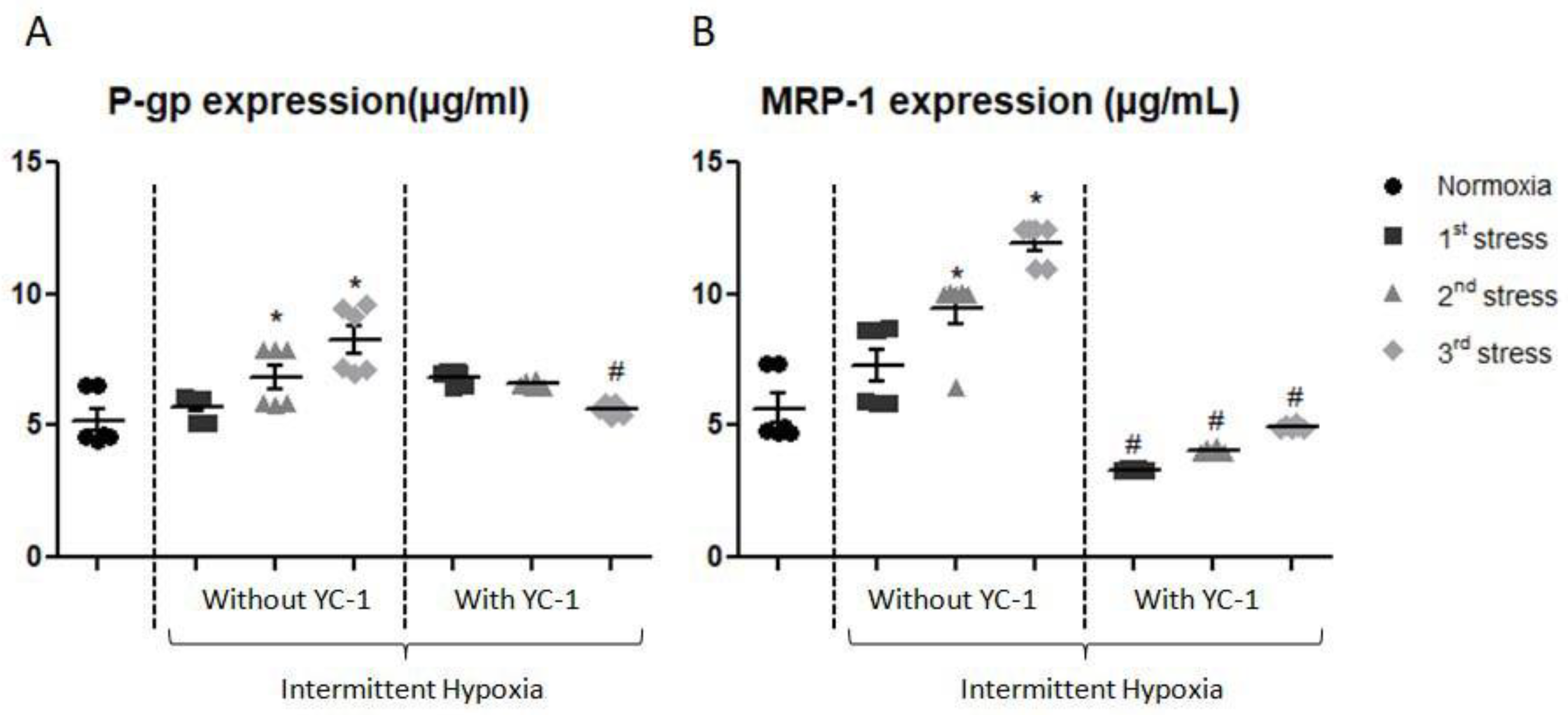
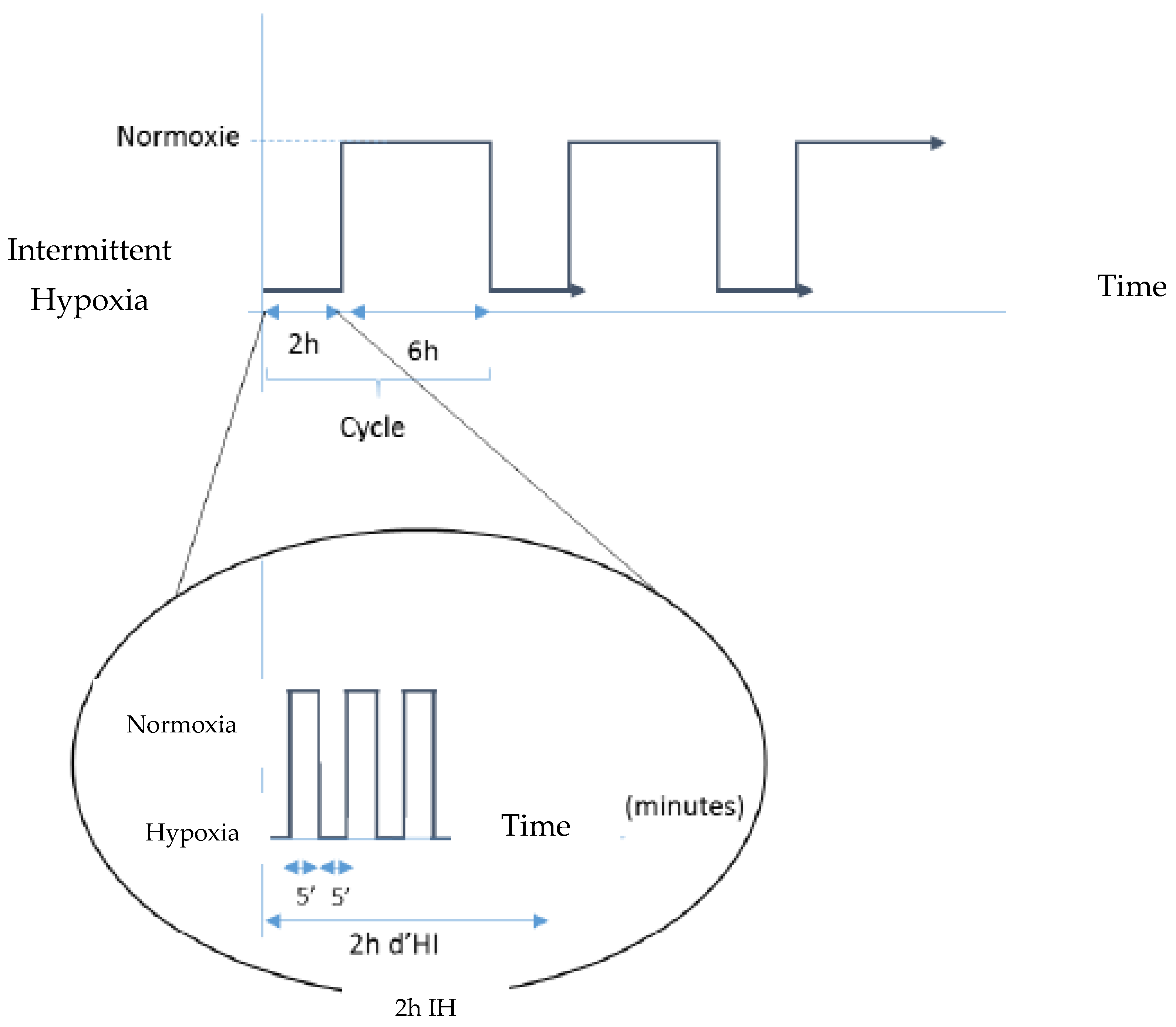
Disclaimer/Publisher’s Note: The statements, opinions and data contained in all publications are solely those of the individual author(s) and contributor(s) and not of MDPI and/or the editor(s). MDPI and/or the editor(s) disclaim responsibility for any injury to people or property resulting from any ideas, methods, instructions or products referred to in the content. |
© 2023 by the authors. Licensee MDPI, Basel, Switzerland. This article is an open access article distributed under the terms and conditions of the Creative Commons Attribution (CC BY) license (https://creativecommons.org/licenses/by/4.0/).
Share and Cite
Voirin, A.C.; Chatard, M.; Briançon-Marjollet, A.; Pepin, J.L.; Perek, N.; Roche, F. Loss of Blood-Brain Barrier Integrity in an In Vitro Model Subjected to Intermittent Hypoxia: Is Reversion Possible with a HIF-1α Pathway Inhibitor? Int. J. Mol. Sci. 2023, 24, 5062. https://doi.org/10.3390/ijms24055062
Voirin AC, Chatard M, Briançon-Marjollet A, Pepin JL, Perek N, Roche F. Loss of Blood-Brain Barrier Integrity in an In Vitro Model Subjected to Intermittent Hypoxia: Is Reversion Possible with a HIF-1α Pathway Inhibitor? International Journal of Molecular Sciences. 2023; 24(5):5062. https://doi.org/10.3390/ijms24055062
Chicago/Turabian StyleVoirin, Anne Cloé, Morgane Chatard, Anne Briançon-Marjollet, Jean Louis Pepin, Nathalie Perek, and Frederic Roche. 2023. "Loss of Blood-Brain Barrier Integrity in an In Vitro Model Subjected to Intermittent Hypoxia: Is Reversion Possible with a HIF-1α Pathway Inhibitor?" International Journal of Molecular Sciences 24, no. 5: 5062. https://doi.org/10.3390/ijms24055062
APA StyleVoirin, A. C., Chatard, M., Briançon-Marjollet, A., Pepin, J. L., Perek, N., & Roche, F. (2023). Loss of Blood-Brain Barrier Integrity in an In Vitro Model Subjected to Intermittent Hypoxia: Is Reversion Possible with a HIF-1α Pathway Inhibitor? International Journal of Molecular Sciences, 24(5), 5062. https://doi.org/10.3390/ijms24055062





